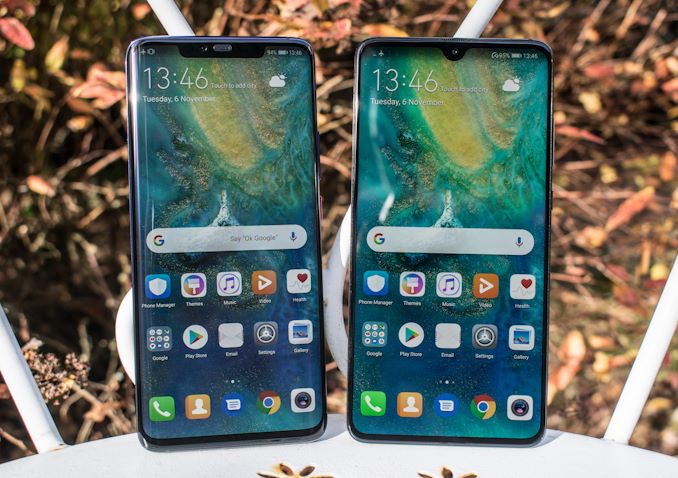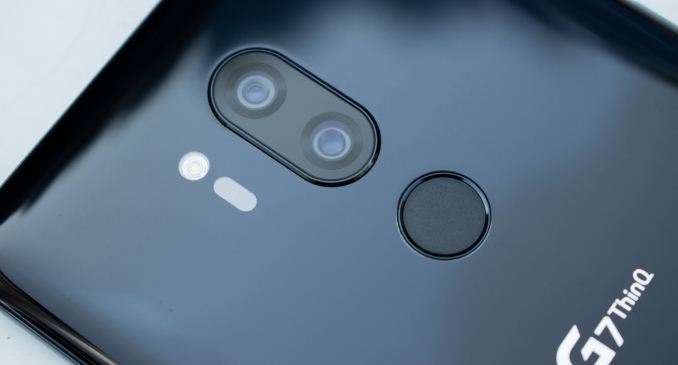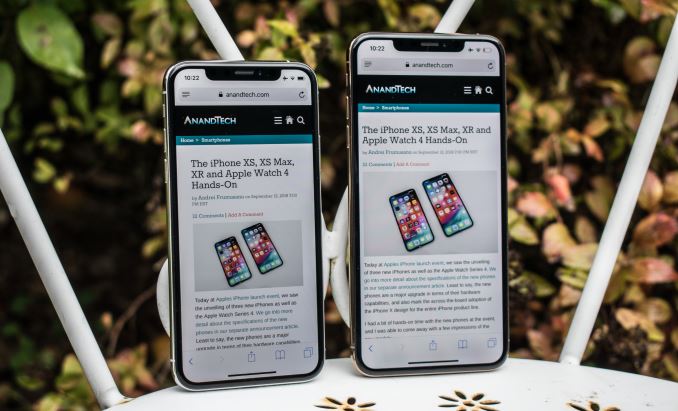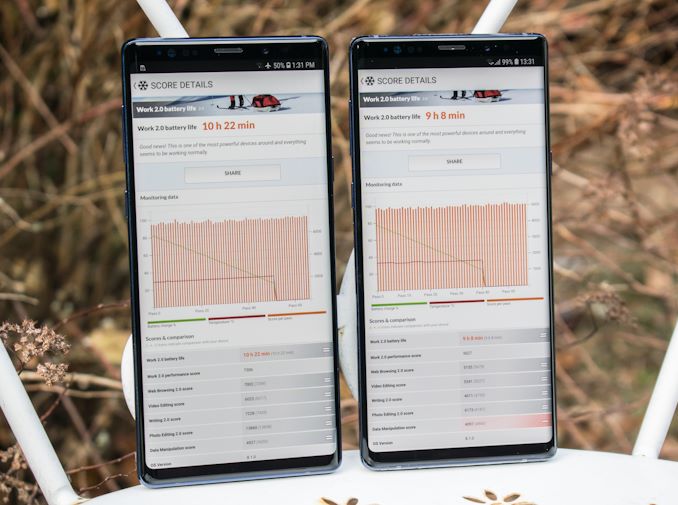AnandTech Year In Review 2018: Flagship Mobile
by Andrei Frumusanu on December 28, 2018 12:00 PM EST- Posted in
- Smartphones
- Apple
- Samsung
- LG
- Huawei
- Mobile
- SoCs
- OnePlus
- Year In Review
Companies’ Product Strategies and Execution in 2018
It would be far too out of scope to address every single product individually in this article, but in general the success of a given device is very much related to the overall execution of a company in this sector.
Huawei in 2018 – Success Years in the Making
I’d like to start off with Huawei in 2018. The company’s devices were the first that I’ve actually got to review at AnandTech a few years ago. Over the years we’ve extensively covered the company’s devices, and were also among one of the early publications to get to visit the company in China. There can be a lot said about the company, particularly about its current woes in the US, but to me this this is something is better addressed another time. Political aspects aside, the company wouldn’t be in this successful position today if it weren’t for its products. A few years ago when we visited the company’s headquarters in Shenzhen the company’s representatives presented a long term goal: To become the #2 smartphone vendor. 2018 was the year that this goal became reality, as Huawei surpassed Apple in terms of global marketshare, and most recently passed the 200 million mark of shipped smartphones for the year.
Over the years, the one thing I’ve been vocal about Huawei’s products is that with every single iteration, they have posted notable improvements in many aspects of its products. I think that 2018 has been a transformative year for the company, as instead of being just a follower, in many aspects is has started to become a leader. The company is the only Android vendor who is vertically integrated with its silicon – featuring its own in-house HiSilicon designed Kirin chipsets. As I’ve addressed on the previous page, this can be a double-edged sword if the execution isn’t perfect. The first half of 2018 was a good example of the potential negative side of this strategy, as the Kirin 970 largely lagged behind the competition in terms of performance and power efficiency.
Still, even though the phones came with an inherent hardware disadvantage, they still saw great success because of the strides the company made in other aspects of the phones. In particular on the camera side of things, the P20 Pro will be remembered as a pioneer device, sporting a camera configuration not seen before in any other smartphone, and raising the bar in terms of photography, especially essentially leading the market in terms of low-light computational photography.
The second half of the year, with the release of the Kirin 980, the company finally had a really competitive engine to put into its chassis. The Mate 20 and Mate 20 Pro have really been massive steps up for Huawei in terms of hardware design, and are by far the best products the company ever made. The phones are not perfect – here Huawei still has to iterate on some aspects, especially when it comes to detail and giving a more polished experience. The Mate 20 Pro comes at a quite premium price – and at this level I would have expected no compromises. Unfortunately Huawei’s choice of going with non-Samsung OLED screen was risky, and unfortunately there’s some quality concerns with units which come with an LG provided panel. I’ve addressed the 3.5mm headphone jack situation on the previous page, and here I find it regrettable that Huawei fell prey to this market tendency. On the software side of things, it’s also arguable that Huawei still has some ways to go to be able to offer a more streamlined and consistent experience.
While Huawei’s 2018 devices aren’t perfect, they are inarguably a step up from its 2017 predecessors, and again I see Huawei as the company with the best potential for the future.
LG in 2018 – The Biggest Disappointment
If I were to name one device in 2018 as the biggest disappointment, then it’s the LG G7. This was meant to be a major jump for the company and present itself as the alternative to Samsung’s Galaxy S9 this year. Unfortunately I do not know what happened within the company this year, as the end products this year’s phones just had notable deal-breaking flaws.
On the camera side, the G7 was a straight downgrade from last year’s LG V30. For whatever inexplicable reason, LG’s image processing this year was just terrible, with washed out or unnatural colours and blurred out details. I’ve given the company the benefit of the doubt as this could be fixed via software, but even 5 months after release with the latest firmware, the situation hasn’t improved. The LG V40 is slightly better, but also showcases the same blurred out detail issues.
What has been of particular issue this year has been LG’s own display panels: The G7’s screen was promised to be very efficient, and this this true at high brightness levels, it came with a very high base power consumption that largely negated this benefit in daily scenarios. The LG V40 is even worse in this regard – sporting one of the highest base power consumption levels I’ve seen in a smartphone over the last 5 or so years. The end result is that the V40 ends up among one of the worst battery life performances this year. Here I think there’s something that’s fundamentally broken on the hardware side, and for some reason this display panel flaw seems to have permeated (To a lesser severity) to other vendor’s devices which use LG screens, most notably the Huawei Mate 20 Pro and the small Pixel 3.
Both the G7 and V40 are devices which should not have been released in their respective states, and the fact that they were points out to QA issues at LG’s hardware teams.
Google in 2018 – Great Cameras – Average Hardware
Google’s biggest positives in 2018 has been the Pixel 3’s new camera, and in particular their adoption of low-light computational photography. While day-light shots haven’t seen any major differences to the Pixel 2, it’s still a relatively good performer – although I do find that the phones not always win out against the competition from Apple, Samsung or OnePlus. Low-light performance on the other hand has been a fantastic experience, and Google’s new Night Sight mode is something to be experienced.
While Google’s software experience is straightforward and simple, it also lacks sometimes in features. Off the top off my head now since we discussed it in the earlier page, things like having any kind of audio play back customisation options is something that’s been around for years on other vendors. Android Pie’s gesture controls are also one of those things Google puts out that make very little sense. The Pixel 3 offers no alternatives to the new pill gesture control, a navigation method that in my opinion serves absolutely no purpose or benefits over the traditional navigation buttons. Every other Android vendor’s custom gesture implementation is superior to Google’s, and at least I’m thankful that the new navigation method is not something that is imposed on other vendors.
The Pixel 3’s biggest lacking however is its hardware. I was a tad disappointed by the build quality of the phone, as the back glass felt flimsy and not as solid as alternatives from the competition. Other hardware flaws include the new speakers which easily distort audio, even though the company promised a focus on speaker experience. While I can’t comment on the Pixel 3 XL, the Pixel 3 also seemingly has worse battery life than the Pixel 2, seemingly because of Google’s choice going with an LG display panel. Speaking of the Pixel 3 XL – Google’s design choice this year with the humongous display notch has been a big miss. The fact that Google avoided showing this aspect of the phone even once during its announcement event points out to a certain level of self-awareness in this regard.
OnePlus in 2018 – Among the Best of 2018 – While Settling on the 6T
The OnePlus 6 has been among one of my favourite devices of 2018. Again, it’s not a perfect device as the phone maybe lacked in some aspects such as its speaker quality. But overall, the OnePlus 6 has been one of the best-rounded packages this year offering excellent value. OnePlus’ execution here was great, and particularly I was impressed by the phone’s daylight camera performance, showing HDR processing very much competing at the very highest end, punching far above its weight in terms of price category.
The OnePlus 6T for me is a bit more controversial, just because it is an iterative generation over the OnePlus 6. The removal of the headphone jack for me is again as addressed in the previous page a big negative, because OnePlus did it for no technical merit, and in a way that doesn’t benefit the end consumer at all.
Still, OnePlus’s execution this year I would say closely follows the KISS principle (Keep-it-stupid-simple). Very robust hardware with great build quality, simple yet performant and streamlined software experience, at a very competitive price.
Apple in 2018 – Perfect Execution, High Prices
This year’s iPhone XS and XS Max in many aspects have been just iterative devices for Apple. Yet this is what Apple does the best, and everything that’s new about 2018’s phones is executed to perfection. The new cameras on the iPhone XSs are straightforward and fantastic upgrades, majorly improving performance and quality. Apple’s low-light performance isn’t quite as innovative as what we’ve seen from the Android devices this year, and if there’s anything that I would say the new iPhones are lacking in, then it would be this.
Apple’s new A12 SoC is just an outstanding piece of silicon, achieving new heights in performance in mobile. Apple’s silicon design teams are clearly at the forefront here – and their execution over the last couple of years feels seemingly unstoppable.
Finally, the real only aspect I can criticise Apple on is their pricing. The new iPhones come at a significant price premium, and Apple is especially putting a heavy price premium on higher tier storage models that I feel is exceedingly hard to rationalise. I’m not sure how this will play out for Apple in terms of sales and overall profit, but I do feel that it has the potential to shift more users to Android alternatives, as even the new “budget” iPhone XR is comes at price points exceeding that of many other competing flagships.
Samsung in 2018 – Flagship Devices in Two Different Variants
My thoughts on Samsung’s 2018 performance is two-fold. On one hand, the Galaxy S9, S9+ and Note9 have been outstanding devices that essentially are the real no-compromise devices of 2018. Samsung has resisted knee-jerk product design decisions such as display notches, removal of headphone jacks, and instead focused on improving the essential aspects of its devices, improving on the excellent base that was established by the Galaxy S8 and Note8 in 2017.
I feel that Samsung has a sufficient level of inertia and critical mass within its design teams that it would be very hard for the company to come out with a product that wouldn’t be successful, however this also means that more often than not the company will chose to play it more safely. For 2018, playing it safe was undoubtedly the wisest choice one could make, as Samsung’s phones, on all aspects that define it as a Samsung phone, have been great successes.
That being said, not every Galaxy S9 or Note9 is the same, and Samsung’s biggest failure this year has been in the heart of the phone: the SoC. If all of Samsung’s devices this year would have been powered by the Snapdragon 845, I would have had no issues to declaring the Galaxy S9 and Note9 the best Android phones of the year (And this might be very valid for the markets who get these variants). However the Exynos 9810’s variant’s handicaps this year has soured the conclusion for Samsung’s phones, as models with this variant of the chipset are just objectively worse phones.
In the past, the dual-sourcing strategy has paid off in terms of risk management, particularly on the Galaxy S6, Samsung was largely able to avoid the troubles of the Snapdragon 810 by exclusively using its own in-house silicon globally that year. However by now we’ve seen that S.LSI’s execution is not always superior, and the last few generations of Exynos SoCs have been lacklustre compared to Snapdragon options.
Samsung’s mobile division here needs to make a choice as to what it wants to do, because essentially right now we have the worst of both worlds. A good analogy is that even given an incredible amount of resources, if you have to spread the work across two platforms, each will only get half the amount of effort put in. S.LSI over the last few years has failed to get any meaningful design wins besides their own sister division, and it largely looks that they’re going nowhere in terms of actually achieving more success in this regard, even with something as simple as achieving 100% of the sockets of Samsung’s own Galaxy flagship devices. It looks to be likely that the new S10 will again come with a variant with the Exynos 9820 and another with the Snapdragon 855. The fact that the latter is manufactured on TSMC 7nm and will be going into Samsung’s own product should be quite an embarrassment to the conglomerate’s own foundry business.
This conflict between the chipset division and the mobile division worries me as to the future competitiveness of the mobile division’s products, because if it doesn’t go all-in in one way or the other, the products will always suffer similar segmentation and discrepancy as we’ve seen in 2018. Also, Apple and Huawei have proven the benefits of full vertical integration. Apple now holds a considerable lead in its SoC performance, and if Huawei will continue to improve and execute correctly, if it doesn’t already today, it will in the future represent a considerable threat to Samsung’s overall business.
Related Reading
- The iPhone XS & XS Max Review: Unveiling the Silicon Secrets
- The Samsung Galaxy S9 and S9+ Review: Exynos and Snapdragon at 960fps
- Improving The Exynos 9810 Galaxy S9: Part 2 - Catching Up With The Snapdragon
- Samsung Galaxy Note9 Performance & Battery Showdown: Snapdragon vs Exynos
- The LG G7 Review: A Rushed Attempt?
- The OnePlus 6 Review: Among The Best Of 2018
- The Huawei P20 & P20 Pro Review: Great Battery Life & Even Better Night Vision
- The Mate 20 & Mate 20 Pro Review: Kirin 980 Powering Two Contrasting Devices
- The Google Pixel 3 Review: The Ultimate Camera Test














65 Comments
View All Comments
sandy105 - Monday, December 31, 2018 - link
I just bought it on a whim because of a great offer, I already had V30+.However I am really used to the OLED on V30+ and S9+ and although the screen brightness is unmatched specifically relevant for HDR videos. I dont enjoy using G7 as much as the screen on S9+ with amazing colors and blacks..
Apart from this I feel front camera is a large improvement over V30 and rear camera has lost some modes compared to V30+ and overall has that painting effects like on newer phones such as Oneplus 6. I was also excited for ability to shoot HDR videos , but well difference is not pronounced.
Performance is top notch but much of that is due to SD 845 rather than LG. I really like the slim profile and makes gripping it easy but it's too tall on the flip side to reach corners.
sandy105 - Monday, December 31, 2018 - link
By slim i meant width because of taller screen ratio, its actually lot thicker than V30.sandy105 - Monday, December 31, 2018 - link
Yup headphone jack is really becoming a pain-point specially with the disappointing audio output via dongles. All my 3 recent phones have headphone jacks and I will probably won't buy one without them.In terms of audio quality I can see a richer sound on G7 & V30. But only on soundmagic E50 earphones which activates high impedance mode , there seems to be a remarkable difference.
In terms of Bluetooth audio with my Sony 1000XM2 the samsung s9+ outshine the LG duo with louder sound and better quality. I have tried all APX & other LDAC settings but it just sounds low in volume and fidelity on my V30 & G7 ThinQ. Quite disappointed with bluetooth performance.
SkyBill40 - Monday, December 31, 2018 - link
The BT doesn't take advantage of the HIFI quad DAC. You need a wired connection for that.Impulses - Tuesday, January 15, 2019 - link
Bluetooth audio really shouldn't differ between phones unless the phone is applying some EQ/DSP to the stream before handing it off...RaduR - Monday, December 31, 2018 - link
Dear Andrei , Xiaomi is the 4th largest phone manufacturer, not OnePlus / Google for sure NOT LG.And out of all people for sure know that , so where are Mi6 and MiMix 3 phones that are flagship and again for sure with a much higher market share than those presented.
Just sayin...
RaduR - Monday, December 31, 2018 - link
Xiaomi Mi8 sorry ! Mi6 is last year ...Retired Budget Gamer - Monday, December 31, 2018 - link
Samsung got me to spend double what I normally spend on a smartphone because of its no compromise specifications (except removable battery).Arbie - Tuesday, January 1, 2019 - link
I just bought a Samsung S9 *because* it takes microSD and has a 3.5mm jack. I won't buy a phone that doesn't.Haawser - Wednesday, January 2, 2019 - link
^This. I already own a 256GB microSD, so any phone manufacturer who wants me to pay $200 or whatever extra for their own built-in memory can forget it. Not going to happen, I'll just find a phone with a microSD slot.